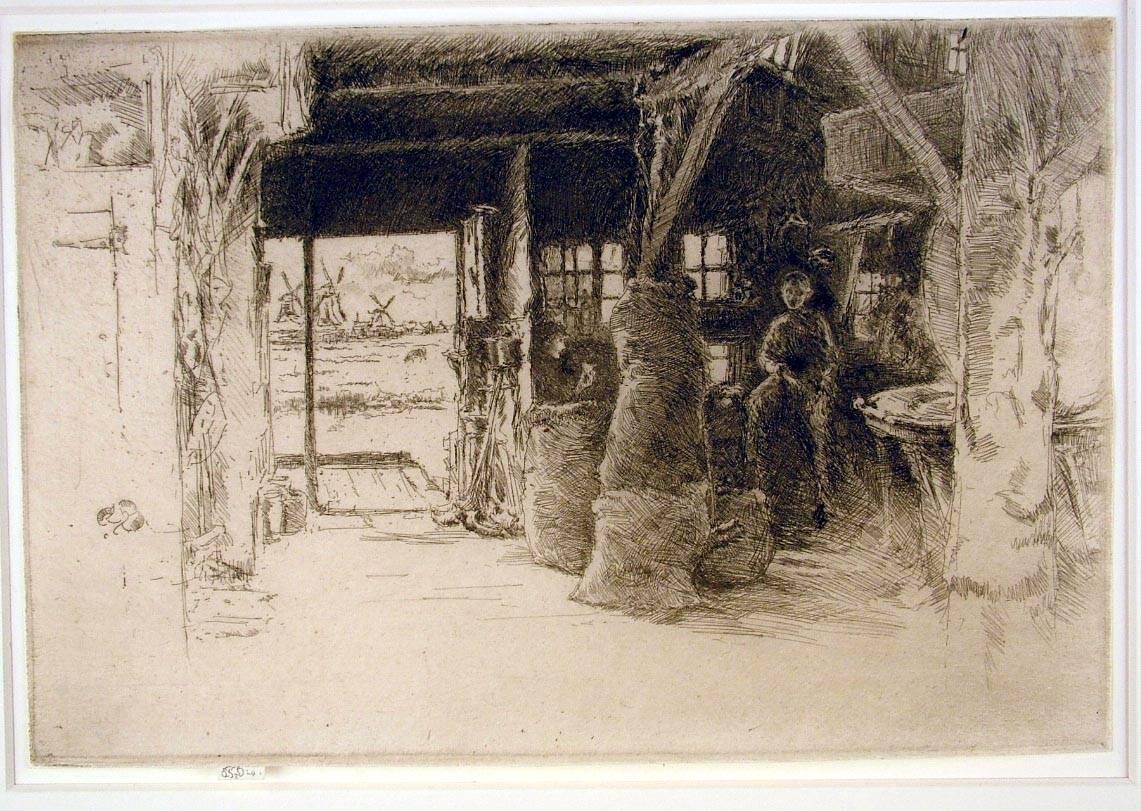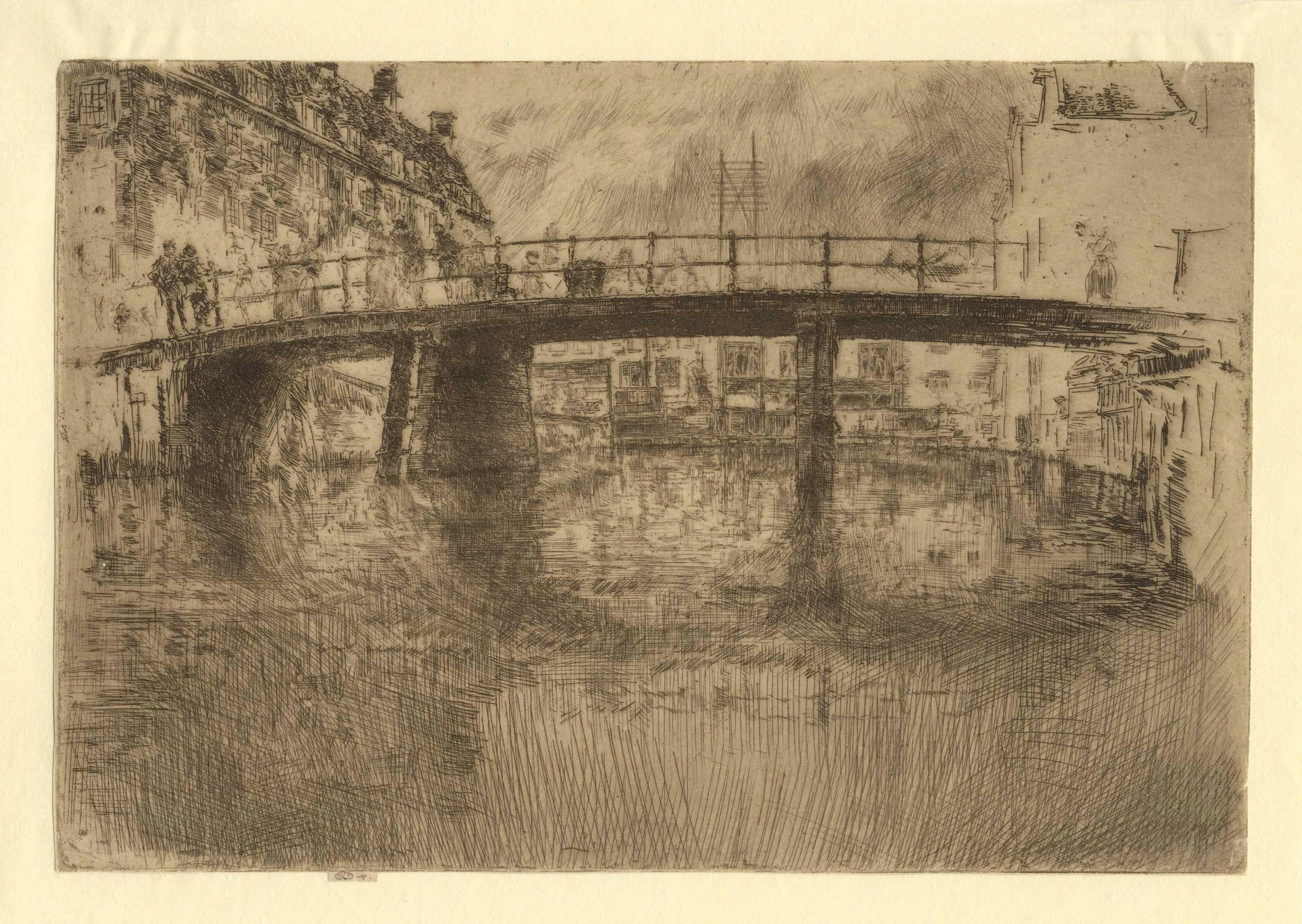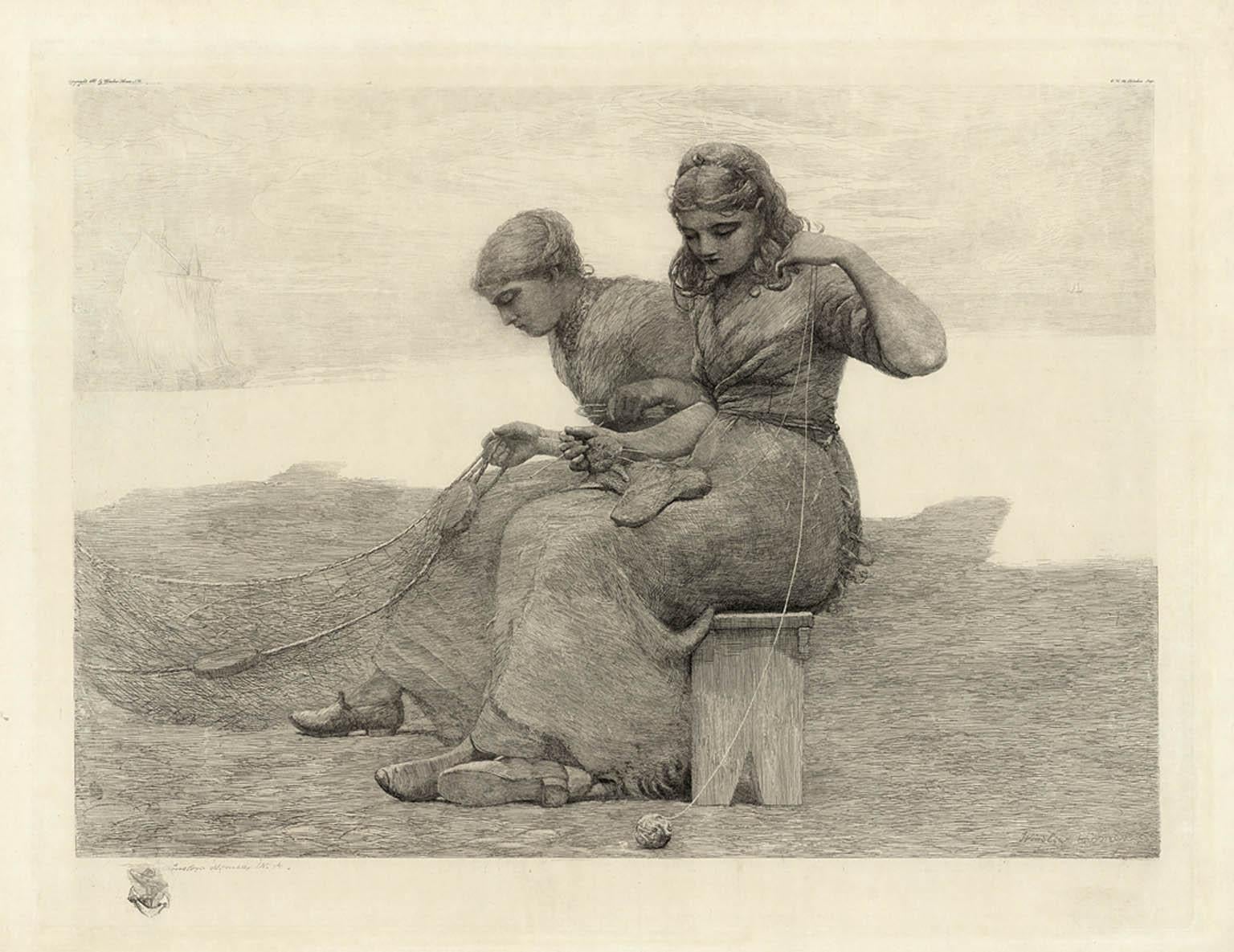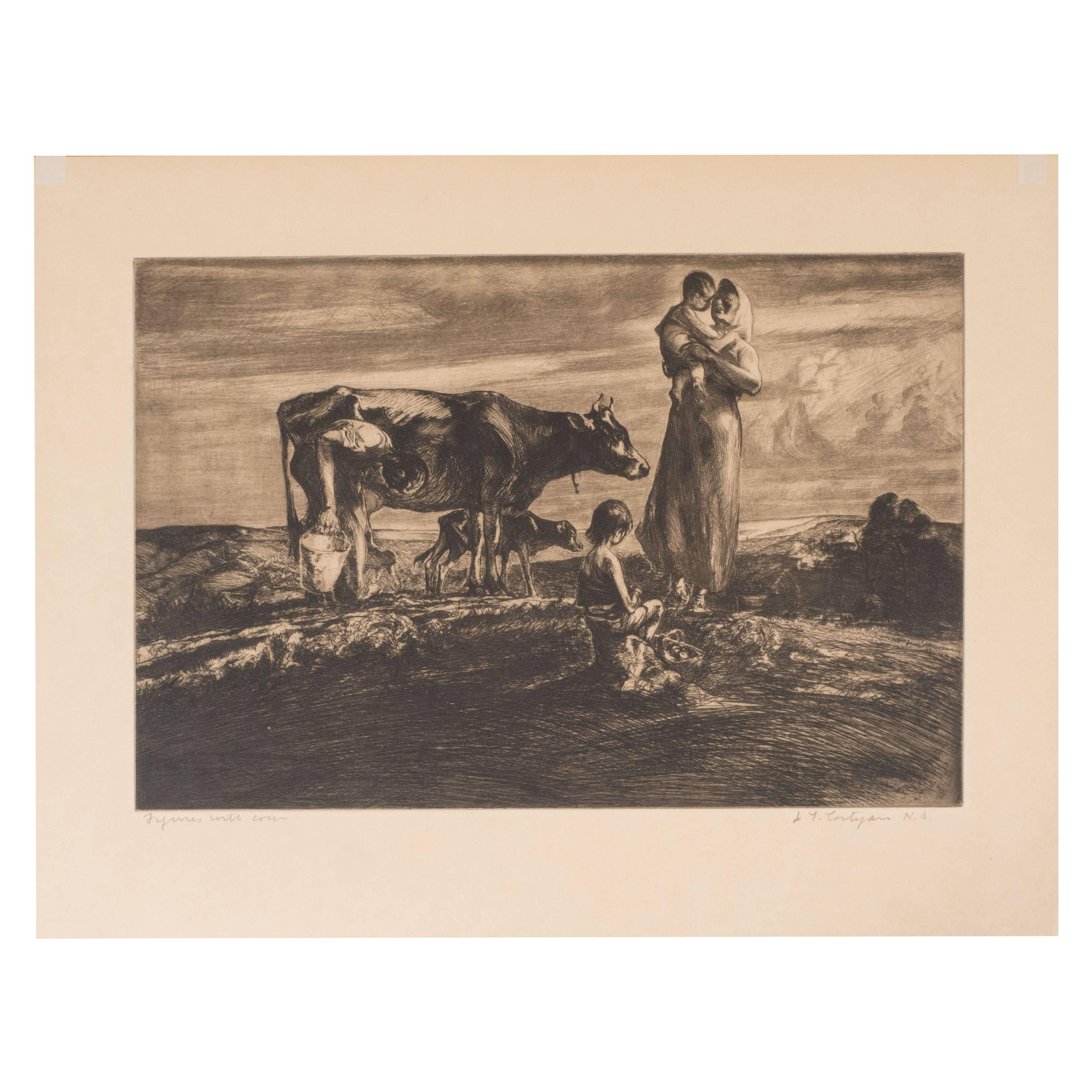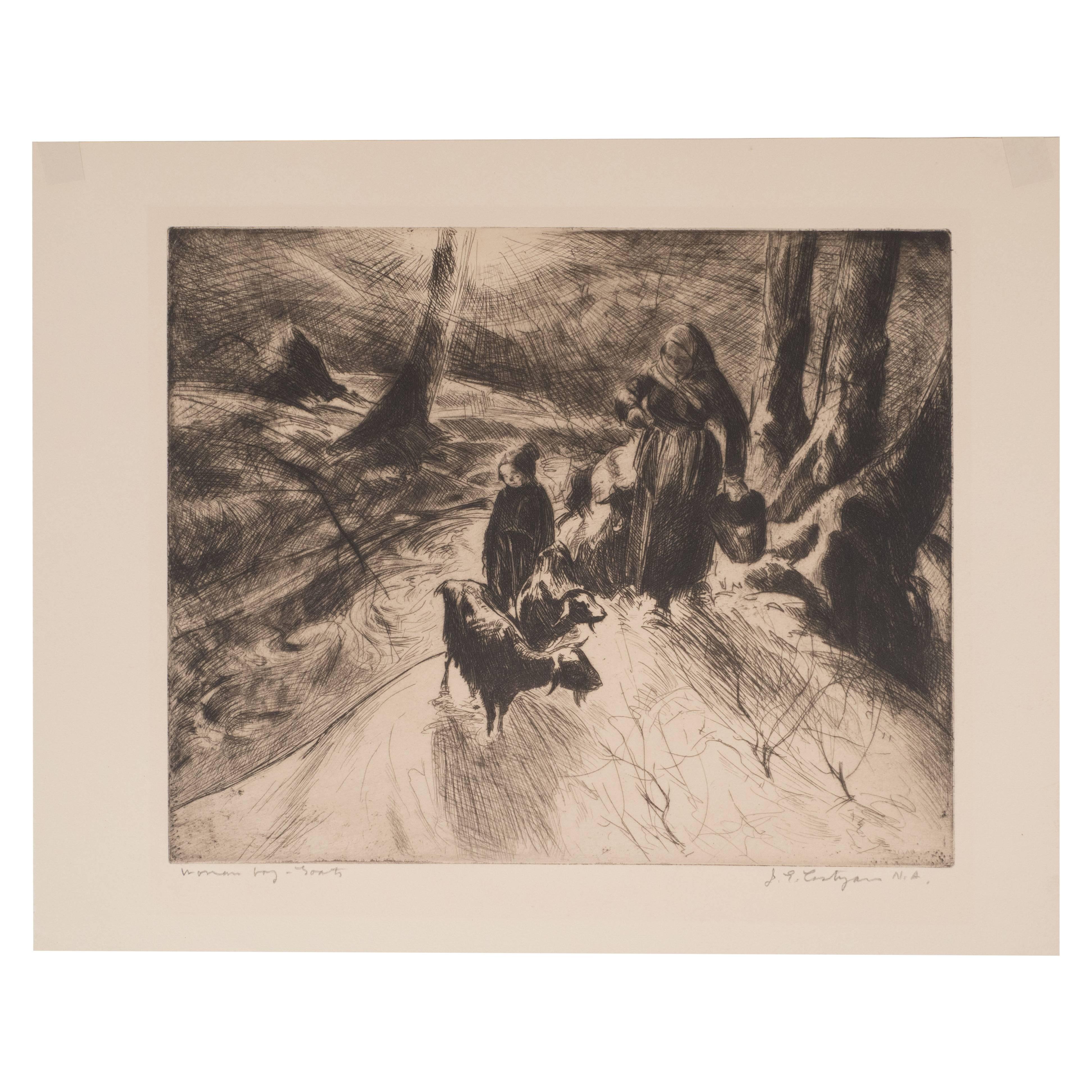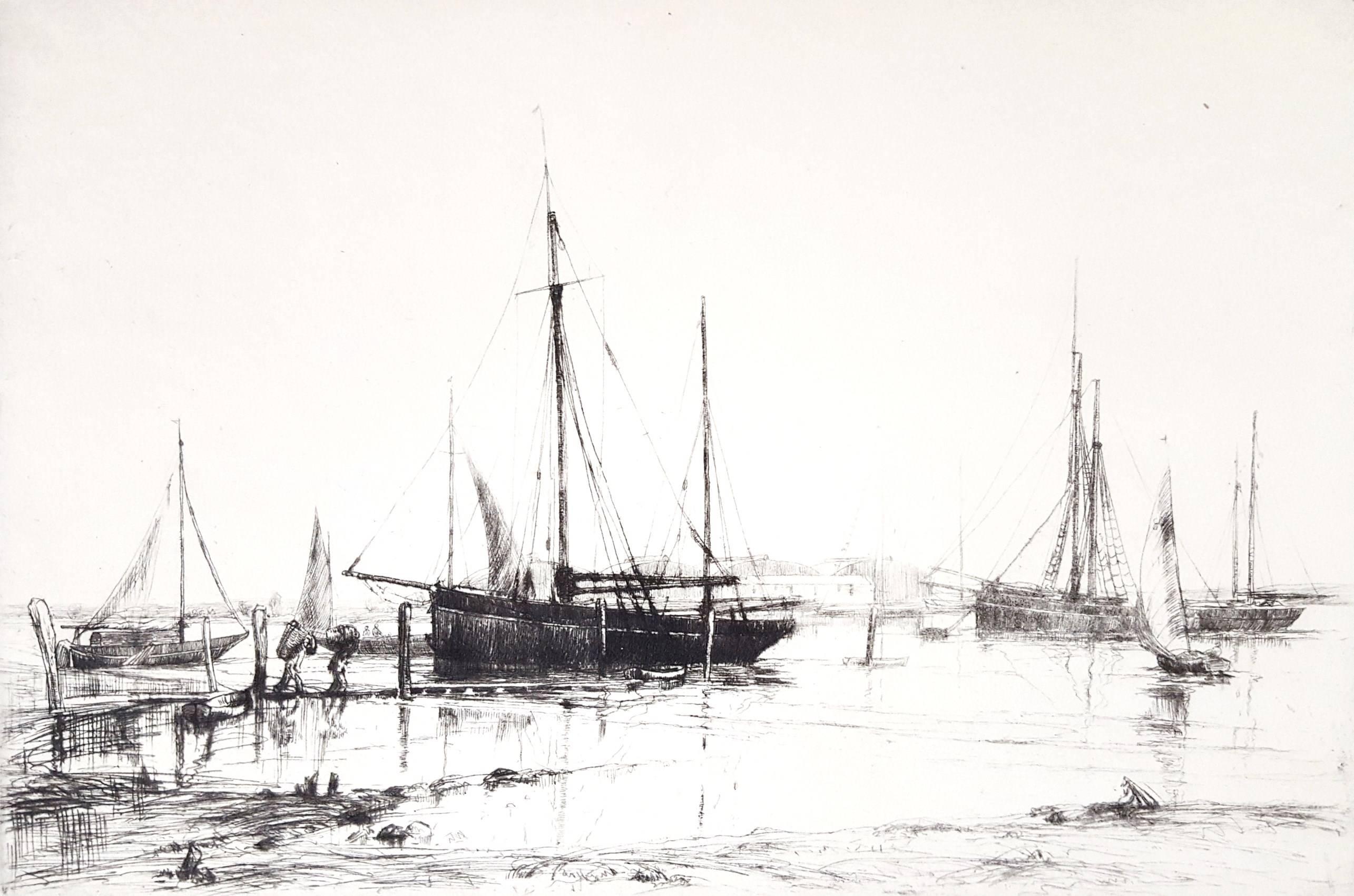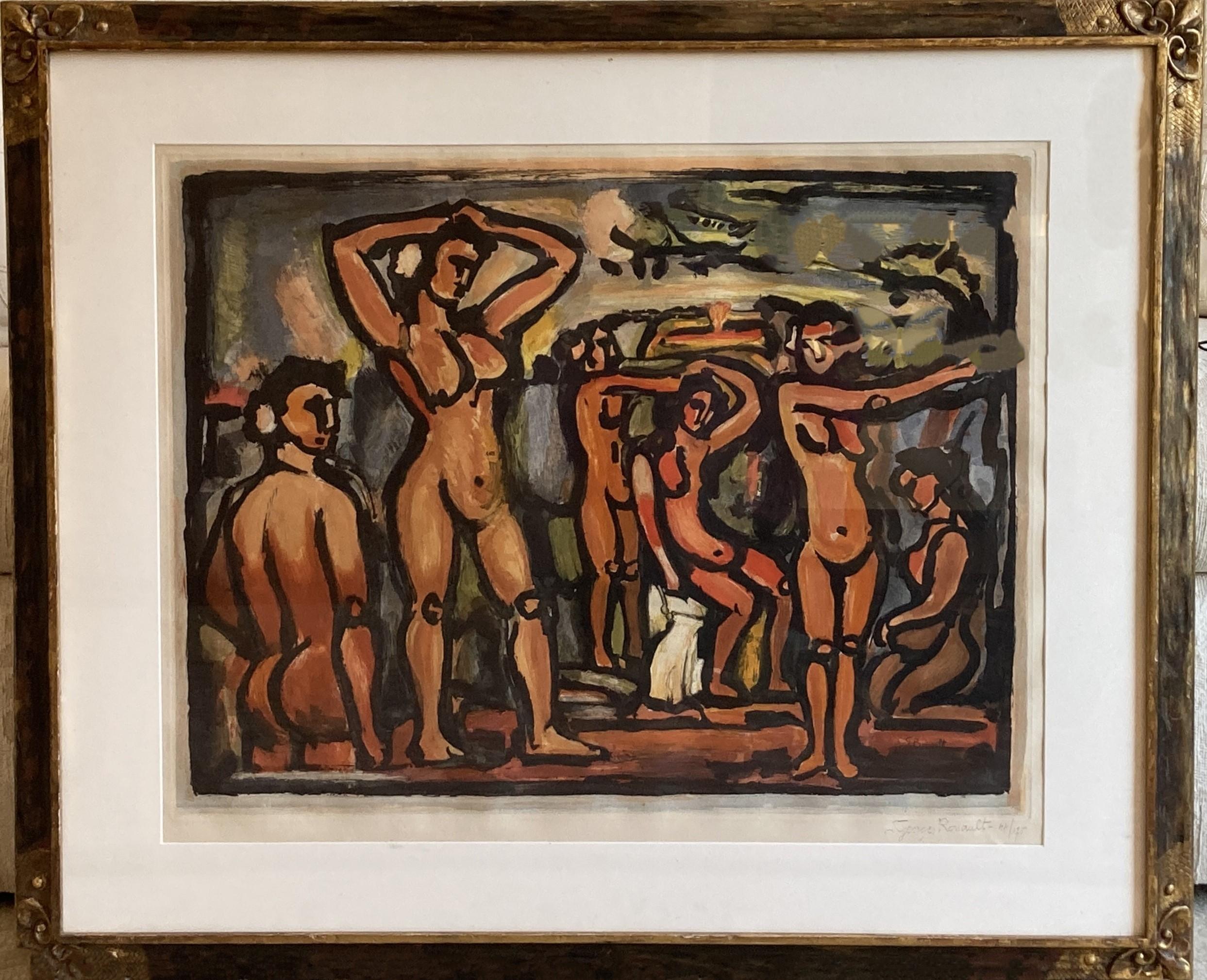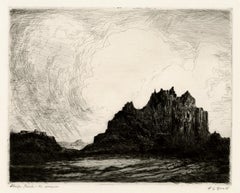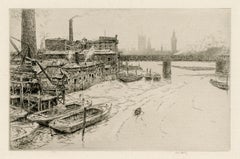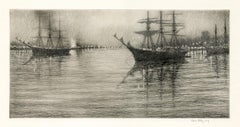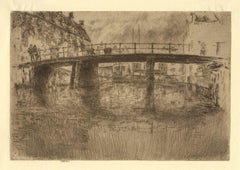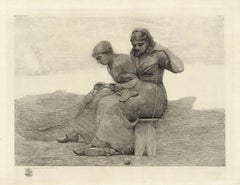
Untitled (Venice Night) — 1920s Impressionist Nocturne
View Similar Items
Want more images or videos?
Request additional images or videos from the seller
1 of 9
Sidney Mackenzie LittenUntitled (Venice Night) — 1920s Impressionist Nocturne
About the Item
- Creator:Sidney Mackenzie Litten (1887 - 1949, British)
- Dimensions:Height: 11.875 in (30.17 cm)Width: 14.25 in (36.2 cm)
- Medium:
- Movement & Style:
- Period:
- Condition:
- Gallery Location:Myrtle Beach, SC
- Reference Number:1stDibs: LU53232052683
About the Seller
5.0
Recognized Seller
These prestigious sellers are industry leaders and represent the highest echelon for item quality and design.
Platinum Seller
These expertly vetted sellers are 1stDibs' most experienced sellers and are rated highest by our customers.
Established in 1995
1stDibs seller since 2016
256 sales on 1stDibs
Typical response time: 1 hour
Associations
International Fine Print Dealers Association
More From This SellerView All
- 'Ship Rock, New Mexico' —By Albert GrollLocated in Myrtle Beach, SCAlbert Lorey Groll, 'Ship Rock, New Mexico', etching, c. 1910. Signed and titled in pencil. A fine, richly-inked impression on cream, wove paper, the full sheet with margins (1 to 1 3/8 inches); a slight paper defect in the center-left margin, away from the image, otherwise in excellent condition. Image size 7 7/8 x 10 inches (200 x 254 mm); sheet size 10 1/8 x 12 15/16 inches (257 x 329 mm). Scarce. Provenance: Ex. collection Kennedy Galleries, in their original gallery mat with label attached. ABOUT THE ARTIST Albert Lorey Groll (1866-1910) was born in New York in 1866, the son of a pharmacist immigrant from Darmstadt, Germany. During his early years, he traveled to Europe to study at the Royal Academy of Fine Arts in Munich under Nicholas Gysis and Ludwig von Löfftz. He further pursued his studies in London and at the Royal Academy of Fine Arts in Antwerp, Belgium. Groll returned to New York in 1895 and moved from figure to landscape painting while expanding his interests to printmaking. In 1904 Groll made the first of several trips to the American Southwest, traveling to Arizona with ethnographer Stewart Culin of the Brooklyn Museum. Later he went to New Mexico with his friend, the artist and illustrator William Robinson Leigh (see our 1stDibs listing no. LU53239015112 ). He focused on impressionistic scenes of Native American lands. The Laguna Pueblo people admired Groll's paintings, honoring him with the name "Chief Bald Head Eagle Eye." Groll kept a studio in the Gainsborough Studios in Manhattan and won several awards for his work in Arizona and New York, including the Salmagundi Club Shaw Prize in 1904 and a gold medal at the Pennsylvania Academy of Fine Arts in 1906. He was also awarded the George Inness gold medal from the National Academy of Design in 1912 for his painting of Lake Louise in the Canadian Rockies. In 1910 he was elected into the National Academy of Design and, in 1919, an associate member of the Taos Society...Category
1910s American Impressionist Landscape Prints
MaterialsEtching
- Hungerford Bridge, LondonBy Kerr EbyLocated in Myrtle Beach, SCKerr Eby 'Hungerford Bridge, London', etching and sandpaper ground, 1929, edition 90, Giardina 144. Signed, titled, and annotated 'Ed 90' in pencil. Signed again in the bottom right sheet corner. A fine, atmospheric impression, with delicate plate tone, on cream wove paper; the full sheet with margins (1 1/2 to 1 5/8 inches), in excellent condition. Matted to museum standards, unframed. Hungerford Foot Bridge spans the River Thames in London, between Westminster Bridge and Waterloo Bridge. Eby visited Great Britain and France during 1924 and 1925. Impressions of this work are in the permanent collection of the following institutions: American Academy and Institute of Arts and Letters, Arizona State University, Boston Public Library, Davison Art Center (Wesleyan University), Herbert F, Johnson Museum of Art, Huntington Museum of Art, Hood Museum of Art (Dartmouth College), Metropolitan Museum of Art, Montgomery Museum of Fine Arts, National Museum of American Art, New York Public Library, Smithsonian Museum of American Art. ABOUT THE ARTIST Kerr Eby was born in 1890 in Tokyo, Japan, the son of Methodist missionaries from Canada. The family returned to Vancouver when Eby was only three, and he grew up studying art encouraged by his parents as his mother was from a family of prominent artists. By age twelve, he had lived in Vancouver, Kingston, Toronto and Bracebridge where he found work as a ‘printer’s devil’ on the local Bracebridge newspaper. After graduating from high school in 1907, Eby moved to New York City to study art, first at the Pratt Institute, and later at the Art Students League. He enrolled in art classes at Pratt Institute while working for a lithographic firm earning $4.00 a week. His pay barely covered his room and drawing supplies. Within a year, starving and feeling defeated, he returned to Canada and was employed by a surveying party in Northern Ontario. Eby gradually regained his dream of becoming an artist, and in his spare time, he began to draw the surrounding wilderness landscapes. By fall he had returned to New York to attend night classes at the Art Students League while working for another lithographic firm. He spent several more summers surveying in Northern Ontario before he was able to make a living as an illustrator. During this period he formed several friendships with influential artists including John Henry Twachtman and Childe Hassam and joined a summer artists' colony founded by them at Cos Cob, Connecticut. He supported himself by working as a magazine illustrator and at the American Lithographic Company. Through diligent study and practice, Eby refined both his drawing and printmaking techniques. In 1917, when the United States entered World War I, Eby joined the U.S. Army. Failing to obtain a commission as an artist, he was assigned first to ambulance duty and later as a sergeant in the 40th Engineers in France. He spent most of WWI on the front line as a camouflager of the field artillery ‘big guns”. On his time off duty, he would sketch everything he witnessed, from the explosive big guns and men in action to the dead soldiers in the field. He sent the drawings home each week, and upon his return from the war, they became the basis for his first successful group of etchings. He continued creating his war-related prints throughout the 1920s and '30s as his work became widely exhibited Frederick Keppel, the renowned print dealer and a relative of Eby, became the exclusive agent for many of his print editions. With another global conflict beginning in the mid-1930s, Eby wanted to show the world the true face of war...Category
1920s Impressionist Landscape Prints
MaterialsEtching
- ShippingBy Kerr EbyLocated in Myrtle Beach, SCKerr Eby 'Shipping' also 'Shipping, Connecticut', etching and sandpaper ground, 1932, edition 100, Giardina 171. Signed in pencil and titled 'Shipping' in the bottom left sheet edge. A superb, atmospheric impression, with skillfully controlled plate tone, on heavy, cream wove paper; the full sheet with wide margins (2 to 2 3/4 inches), in excellent condition. Matted to museum standards, unframed. Image size 8 3/8 x 17 1/4 inches (316 x 176 mm); sheet size 13 7/16 x 8 3/8 inches (341 x 213 mm). The scene depicted was on the Connecticut coast...Category
1940s American Impressionist Landscape Prints
MaterialsEtching
- St. Paul's Church (St. Paul's Chapel, New York City)By Bror Julius Olsson NordfeldtLocated in Myrtle Beach, SCB.J.O. Nordfeldt, 'St. Paul's Church' (St. Pauls' Chapel), etching, edition not stated, c. 1915. Signed in pencil. A superb, richly-inked impression, with skillfully controlled plate tone, printed on off-white, antique, laid paper; the full sheet with margins (5/8 to 2 1/4 inches), in very good condition. Scarce. Matted to museum standards, unframed. An impression of this work is in the permanent collection of the Smithsonian American Art Museum. ABOUT THE ARTIST A solo exhibition of Nordfeldt’s etchings and woodcuts was presented by the Smithsonian Institution in 1926. In 1920, Nordfeldt had a one-man show at the Chicago Arts Club. In 1926, he won the bronze medal at the sesquicentennial exposition in Philadelphia and the Logan Medal at the Art Institute of Chicago. In 1927, he won the first annual prize from the Brooklyn Society of Etchers, and the following year he won first prize from the Chicago Society of Etchers. In 1929, Nordfeldt had a one-man show at the Denver Art Museum. Nordfeldt's work is held in numerous museum collections including Amon Carter Museum of Western Art, Ft. Worth; Anschutz Collection, Denver; Art Institute of Chicago; Biblioteque d’Art et d’Archeologie, Paris; British Museum, London; Corcoran Gallery of Art, Washington, DC; Los Angeles County Museum; Metropolitan Museum of Art, New York City; Museum of Fine Arts, Santa Fe; National Museum of American Art, Smithsonian Institution, Washington, DC; National Gallery, Sydney, Australia; Phillips Collection, Washington, DC. ABOUT ST. PAUL'S CHAPEL St. Paul's Chapel, nicknamed "The Little Chapel That Stood", is an Episcopal chapel located at 209 Broadway, between Fulton Street and Vesey Street, in Lower Manhattan, New York City. Built in 1766, it is the oldest surviving church building in Manhattan, and one of the nation's finest examples of Late Georgian church architecture. It is a New York City Landmark and a National Historic Landmark. The Hearts of Oak, a militia unit organized early in the American Revolutionary War, and composed in part of King's College (later, Columbia University) students, would drill in the Chapel's yard before classes nearby. Alexander Hamilton was an officer of this unit. The chapel survived the Great New York City Fire of 1776 when a quarter of New York City (then confined to the lower tip of Manhattan), including Trinity Church, burned following the British capture of the city after the Battle of Long Island during the American Revolutionary War. George Washington, along with members of the United States Congress, worshipped at St. Paul's Chapel on his Inauguration Day, April 30, 1789. Washington also attended services at St. Paul's during the two years New York City was the country's capital. Above Washington's pew is an 18th-century oil painting of the Great Seal of the United States, adopted in 1782. The rear of St. Paul's Chapel faces Church Street, opposite the east side of the World Trade Center site. After the attacks on September 11, 2001, which led to the collapse of the twin towers of the World Trade Center, St. Paul's Chapel served as a place of rest and refuge for recovery workers at the WTC site. For eight months, hundreds of volunteers worked 12-hour shifts around the clock, serving meals, making beds, counseling and praying with firefighters, construction workers, police, and others. Massage therapists, chiropractors, podiatrists, and musicians also tended to their needs. The church survived without even a broken window. Church history declares it was spared by a miracle sycamore on the northwest corner of the property that was hit by debris. The tree's root has been preserved in a bronze memorial...Category
1910s American Impressionist Landscape Prints
MaterialsEtching
- 'Black Hawk Country' — Early 20th-Century American ImpressionismLocated in Myrtle Beach, SCRalph M. Pearson, 'Black Hawk Country', etching, second state, edition not stated, 1912. Signed, and titled in pencil. Inscribed 'Rock River Series Second...Category
1910s American Impressionist Landscape Prints
MaterialsEtching
- 'North Boulder Creek, Colorado' —Southwest American ImpressionismBy George Elbert BurrLocated in Myrtle Beach, SCGeorge Elbert Burr, 'North Boulder Creek, Colorado', etching, c. 1915, Seeber 99. A superb, luminous impression, in dark sepia ink, with skilfully wiped plate tone, on cream laid pap...Category
1910s American Impressionist Landscape Prints
MaterialsEtching
You May Also Like
- The Mill, Amsterdam, 1889By James Abbott McNeill WhistlerLocated in New York, NYJames Whistler (1834-1903), The Mill, 1889, etching and drypoint, signed in pencil with the butterfly on the tab and inscribed “imp”, and inscribed “first state” (twice) and annotated “Wunderlich” and signed again with the butterfly verso. Reference: Kennedy 413, first state (of 5). Glasgow 457, second state (of 6; see discussion below) (cf. Margaret F. MacDonald, Grischka Petri, Meg Hausberg, and Joanna Meacock, James McNeill Whistler: The Etchings, a catalogue raisonné, University of Glasgow, 2011) On laid paper, in very good condition, trimmed just outside of the platemark all around except for the tab by the artist, 6 1/4 x 9 3/8 inches. A very fine impression of this great rarity, printed in black/brown ink with a slight veil of plate tone. provenance: H. Wunderlich & Co., New York Louis B. Dailey, New York (Lugt 4500) sale, Sotheby’s, New York, October 31, 2003, lot 69 literature; Neue Lagerliste 122: James McNeill Whistler – Etchings...Category
1880s Impressionist Landscape Prints
MaterialsDrypoint, Etching
- Bridge, AmsterdamBy James Abbott McNeill WhistlerLocated in New York, NYJames McNeill Whistler (1834-1903), Bridge, Amsterdam, etching, 1889, printed in brown ink on thin laid paper, signed with the butterfly on the tab and annotated “imp”, also signed with the butterfly on the verso and numbered 11. References: Kennedy 409, Glasgow 447, fifth state (of 5). In very good condition (slight nicks at edges), trimmed by the artist on the plate mark apart from the tab, 6 1/2 x 9 1/2 inches. Provenance: Vivian and Meyer P. Potamkin, Philadelphia; sale, Sotheby’s, New York, May 11, 1989, lot 302 Samuel Josefowitz, Pully, Switzerland A very fine, shimmering impression of this great rarity. This impression is included in the Glasgow inventory, ID number K4090301; only about 11 lifetime impressions in all states are known (three were also printed posthumously by Nathaniel Sparks...Category
1880s Impressionist Landscape Prints
MaterialsEtching
- Mending the TearsBy Winslow HomerLocated in New York, NYWinslow Homer created this etching entitled “MENDING THE TEARS” in 1888. This is a lifetime impression signed by Homer and printed by the famous New York etcher George W. H. Ritchie...Category
1880s American Impressionist Figurative Prints
MaterialsEtching
- J.H. Woods’ Fruit Shop, ChelseaBy James Abbott McNeill WhistlerLocated in New York, NYJames Whistler (1834-1903), J.H. Woods’ Fruit Shop, Chelsea, etching and drypoint, 1887-88. Signed with the butterfly on the tab and annotated “imp,” also signed with the butterfly in pencil verso and numbered “1”. References: Kennedy 265 second state (of 2), Glasgow 327 second state (of 4). Trimmed by the artist around the plate mark except for the tab, in excellent condition. Printed in black ink on ivory laid paper, 3 3/4 x 5 1/8 inches. A fine impression of this great rarity; the print was never published. Glasgow accounts for four impressions. watermark: partial arms of Amsterdam(cf. Spink/Stratis/Tedeschi, watermark nos. 12ff.) This is before the third state in which heavy shading was added around the woman at the center, and the heads of figures at right and left of the figure are defined. In Glasgow’s fourth state the shading and the figure were removed; no impression is known of this state, but the state is inferred from the cancelled plate. According to Glasgow “Joseph Henry Wood had a greengrocer’s shop at 1 Park Walk...Category
1880s Impressionist Landscape Prints
MaterialsEtching, Drypoint
- Charing Cross Bridge - 1909 etching of London by Joseph PennellBy Joseph PennellLocated in London, GBJOSEPH PENNELL (1857-1926) Charing Cross Bridge at Night, 1909 Signed Etching Plate size17.5 by 25 cm., 7 by 10 in. (frame size 38.5 by 45 cm., 15 ¼ by 17 ¾ in.) Pennell was born in Philadelphia where he studied at School of Industrial Art and the Academy of Fine Arts. In 1884 he was commissioned by the Century Magazine to supply a series of drawings of London...Category
Early 20th Century Impressionist Landscape Prints
MaterialsEtching
- La rentrée du Berger by Camille Pissarro - EtchingBy Camille PissarroLocated in London, GBLa rentrée du Berger by Camille Pissarro (1830-1903) Etching 7.6 x 10.9 cm (3 x 4 ¹/₄ inches) Stamped with initials C.P. lower left, and numbered 13/18 lower right This work was crea...Category
1880s Impressionist Landscape Prints
MaterialsEtching
